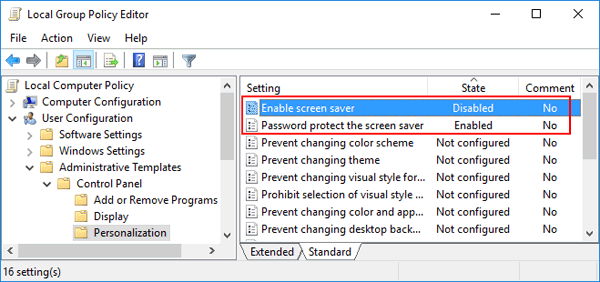Group Policy Screensaver Settings
My management decided to set the same slideshow screensaver on all PCs in the company. The images of the slideshow should have corporate design and provide general rules of information security, useful tips or some other reference information.
First of all, they considered the development of their own screensaver in.scr format, but this method required some extra software and was not flexible and easy enough to manage it. It resulted in a solution to distribute images and to manage the screensaver on an Active Directory domain using GPO. Configuring Scheduled Task Item using Group PolicyThen create a script file copyscreens.bat, which will connect clients to this network share and copy the screensaver images to C:Screen folder on the local disk of each computer.
The code of the script copyscreens.bat is shown below.net use s: fsrv1InstallImgmkdir C:Screendel /Q C:Screen.xcopy S:. C:ScreenCopy this script to SYSVOL folder on the domain controller (C:WindowsSYSVOLsysvolcontoso.comscripts). Then using the Group Policy Editor, create a new policy or edit an existing one.

A Group Policy is configured to enable Screensaver. User Configuration Administrative Templates Control Panel Personalization. Enable screen saver. But there is no setting defining a ScreenSaverTimeout configured in. Screen saver timeout. The Screensaver won't start in such a configuration by default.
To demonstrate, we’ll run the copy task using a one-time Task Scheduler job (if you need to refresh slides, run this task again). Create a new task for the Task Scheduler for all PCs using GPO. Run the task using the following account:%LogonDomain%%LogonUser%Add a new trigger: New Trigger - On a Schedule - One Time in the Triggers tabIn the Action tab, specify that the following script has to be run: contoso.comSYSVOLcontoso.comscriptscopyscreens.batSave the changes in the task and assign the policy to the OU with the users. Configuring Screensaver Settings on a Reference PCNow you need to configure your screensaver on a reference computer so that it took the images for the slide show from C:Screen. The settings of the corresponding registry keys on this computer will be distributed to all PCs using Group Policy. The folder C:Screen must exist on a reference computer.In Windows 10, go to the following settings section: Start - Settings - Personalization - Lock Screen.
Scroll down to find Screen Saver Settings. Select ‘Photos’ as a screensaver and click Settings.Specify the path to C:Screen, tick Shuffle Pictures and save the changes.Now export the following registry branch HKEYCURRENTUSERSoftware MicrosoftWindows Photo ViewerSlideshowScreensaver in a.reg file and import it on the domain controller (or another computer, on which you edit the GPO). The path to the folder containing the images is stored in encrypted (Base64) EncryptedPIDL parameter, so you won’t be able to change it manually.
Active Directory Group Policy Screensaver Settings
Since Windows doesn’t wrap the lines in the value of this parameter correctly, you have to manually edit.reg file (in the NotePad) so that the value of EncryptedPIDL key goes as a single line.Save the.reg file and import it to the computer, on which you edit the GPO. GPO to Manage ScreensaverOpen your policy and go to the following GPP branch: User Configuration - Preferences - Windows Settings - Registry. Create a new parameter: New Registry Wizard Next.
Go to HKEYCURRENTUSER - Software - Microsoft - Windows Photo Viewer - Slideshow - Screensaver. Check the following keys and click Finish:.
EncryptedPIDL. Shuffle. SpeedThen go to the following GPO section: User Configuration - Policies - Administrative Templates - Control Panel - Personalization. Enable Force specific screen saver, and specify PhotoScreensaver.scr as its value. (By default, Photoscreensaver.scr uses the folder C:UsersPublicPicturesSample Pictures as the source of the screensaver images.). You can also enable these policies in the Personalization section. Enable Screen Saver.
Password Protect Screen – protects the Lock Screen with a password. Screen Saver timeout – the timeout in seconds that triggers the automatic start of the screensaverThat’s all, close Group Policy Management console and update the policies on the clients (gpupdate /force). A single corporate slideshow screensaver that takes images from c:Screen will start on all domain computers after a specific timeout.
Group Policy Screensaver Settings For Windows 10
If your sytem is not connected to a domain, then try this:Start Regedit.exe and goto: HKEYCURRENTUSERSoftwarePoliciesMicrosoftWindowsControl PanelDesktopDelete these values in the right-pane:.SCRNSAVE.EXE.ScreenSaverIsSecure.ScreenSaveTimeoutRepeat the same here, if the key/values are present: HKEYLOCALMACHINESoftwarePoliciesMicrosoftWindowsControl PanelDesktopLogoff and login back.If you've used the Local Group Policy Editor to configure ScreenSaver Policy, you need to reverse the settings there instead of Regedit.exe.